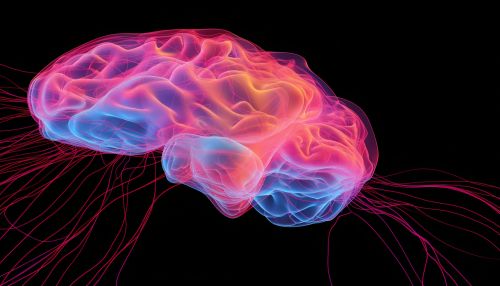Neuroscience of laughter
Introduction
The neuroscience of laughter is a complex field that seeks to understand the neurological processes that underlie the act of laughter. This involves the study of the brain and nervous system, as well as the physiological and psychological aspects of laughter. This field of study is part of the broader discipline of affective neuroscience, which focuses on the neural mechanisms of emotion.


Neuroanatomy of Laughter
Laughter is a complex response that involves many areas of the brain. The primary regions implicated in the production and perception of laughter include the amygdala, hypothalamus, thalamus, frontal lobe, and cerebellum.
Amygdala
The amygdala, located deep within the medial temporal lobes, plays a key role in processing emotions, including the positive emotions that often accompany laughter. It is thought to contribute to the emotional coloring of laughter, helping to distinguish between genuine and forced laughter.
Hypothalamus
The hypothalamus, a small region at the base of the brain, is involved in the regulation of basic bodily functions, including hunger, sleep, and emotional responses. It is believed to play a role in the initiation of laughter, particularly in response to physical stimuli or tickling.
Thalamus
The thalamus acts as a relay station for sensory information, directing signals from the body to the appropriate areas of the brain. It is thought to play a role in the perception of laughter, helping to interpret the sensory cues associated with laughter, such as facial expressions and vocalizations.
Frontal Lobe
The frontal lobe, located at the front of the brain, is involved in cognitive functions such as decision-making, problem-solving, and social interaction. It is thought to play a role in the cognitive aspects of laughter, such as understanding humor and appreciating jokes.
Cerebellum
The cerebellum, located at the back of the brain, is primarily associated with motor control but also plays a role in cognitive functions. It is thought to coordinate the physical act of laughing, helping to regulate the timing and intensity of laughter.
Neurophysiology of Laughter
Laughter triggers a series of physiological responses that involve various parts of the brain and body. These responses include the contraction of facial muscles, the release of certain hormones, and changes in heart rate and breathing.
Facial Muscles
Laughter involves the contraction of various facial muscles, particularly those around the mouth and eyes. This is controlled by the motor cortex, a part of the brain that regulates voluntary movements.
Hormonal Release
Laughter triggers the release of several hormones, including endorphins, dopamine, and serotonin. These hormones contribute to the pleasurable feelings often associated with laughter and can have a range of effects on the body, from pain relief to mood enhancement.
Heart Rate and Breathing
Laughter also affects the cardiovascular and respiratory systems, causing changes in heart rate and breathing. This is thought to be regulated by the autonomic nervous system, which controls involuntary bodily functions.
Neuroscience of Humor
Understanding the neuroscience of humor is a key aspect of studying the neuroscience of laughter. Humor involves the recognition and appreciation of incongruity, surprise, and absurdity, and it often leads to laughter. The neural mechanisms underlying humor are complex and involve various parts of the brain.
Recognition of Incongruity
The recognition of incongruity, a key element of humor, involves the temporal lobe. This part of the brain is associated with processing sensory input and is thought to play a role in recognizing discrepancies between expected and actual outcomes, a common source of humor.
Appreciation of Humor
The appreciation of humor involves the mesolimbic pathway, a dopamine-rich pathway in the brain associated with reward and pleasure. This pathway is thought to be activated when a humorous stimulus is perceived, leading to feelings of enjoyment and often, laughter.
Clinical Applications
The neuroscience of laughter has important clinical applications, particularly in the fields of neurology, psychiatry, and psychology. Understanding the neural mechanisms of laughter can help in the diagnosis and treatment of various neurological and psychiatric disorders, and it can also provide insights into human behavior and emotion.
Neurological Disorders
Certain neurological disorders, such as Parkinson's disease and epilepsy, can affect the neural pathways involved in laughter. Studying these disorders can provide insights into the neurobiology of laughter and can also help in the development of treatments.
Psychiatric Disorders
Laughter can also be affected by psychiatric disorders, such as depression and schizophrenia. Understanding the neuroscience of laughter can help in the diagnosis of these disorders and can also inform treatment strategies.
Behavior and Emotion
Understanding the neuroscience of laughter can also provide insights into human behavior and emotion. Laughter is a universal human behavior that plays a key role in social interactions, and it is also a powerful emotional response that can have a profound impact on mood and well-being.
